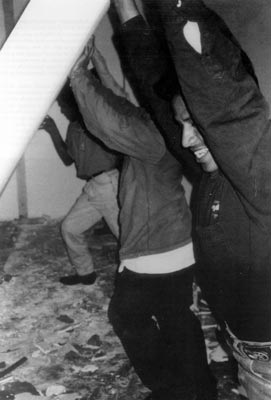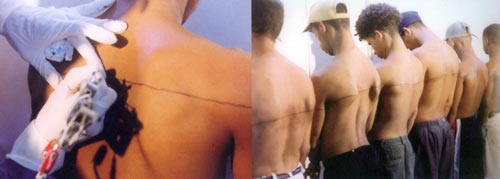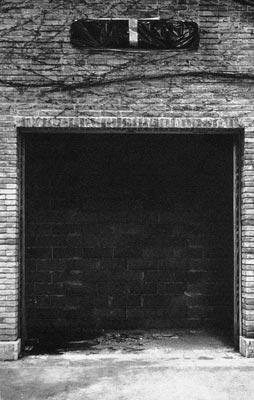
Santiago Sierra is one of the artists who drewon the main leads of the readymade Duchamp-style.On one side is the position taken by the fictional shaman Joseph Beuys: the work of art should become a perennial subject of discussion.On the other hand, we find one of the axioms that reveal the pop ideology of nihilist cheater Andy Warhol: “I want to be a machine”. Although Sierra ends up clinging to his main purpose: to disassemble or to transgress the classical minimalism until adding a physical and mental dynamics appropriate to the circumstances of the time. His spearhead is a counterpoint between the movement of a “suitcase artist” and the inertia of social losers he uses as poor materials. All this is done with the intention of shooting straight to the contemporary relationships between mass and power.In order to do so, he relies on an axiom of Sol LeWitt: “The idea becomes a machine that produces art.”
Like Belgian artist Francis Alÿs, living in Mexico City since 1995 allowed Santiago Sierra (Madrid, 1966) to discover a “huge outdoor laboratory” that in experimenting with his antagonisms would be defined as “a summary of planet Earth”. That system of resistance to modernity visible in a megalopolis suited the intentions of the new intruder: to recreate the capitalist exploitation of wage labor in an attempt to merge art and economy, minimalism and post performance, difference and repetition. As his strategic partner Alÿs, Sierra started working from the bottom up to the moment he leapt to fame in the field of conceptual Mexican art as one of those emergencies that no intellectual elite vanguard should ignore.
“The cube is not the cube”
Since his Iberian trip, Sierra proposes a symbolic replacement of the minimalist notion of the “epistemological cube” for a real emblem of the productive process: the container.Without resigning the premise that “less is more” learned from his teachers, the artist attempts to defy the formal austerity by resorting to the elements that activate his poetry: the body, the movement and the disappearance of the object that generates the action.These variants become effective when the cube is no longer working as a logical dogma where the form dominates the content.
In a piece like “Placement exercise for four cubic containers” (Hamburg, Germany, 1991) is observed an attempt at overcoming the traditional minimalist in the scale and volume of the installation breaking into space.Nevertheless,the difference between the cube and the container continues to be minimal, since the content of both is an abstraction for the common viewer.The point is that Sierra’sprocesual “emptiness” implies the “fullness” of the effort of the hired hand work to prepare and place the cubic containers in the exhibition room.The paradox this exercise implies will be a constant in the artist’s critical operation: humanizing the minimal through its own dehumanization.
Santiago Sierra’s moving or edible cubes interact with the vulnerable zone of society: emigration and starvation, irrational waste of time and the aimless space leveling. Despite the transgressor intention, what is shown is an illusion of change when the object breaks the quietness to finally return to its real or imaginary module.
There are times when in Santiago Sierra’s actions his utilitarianism converges in terms of means and ends.One of them took place at the Student’s Square in Mexico City (2003). He had a solid bread cube done and it was given as a charitable gesture to a homeless shelter.By removing the usual pattern of remuneration, the artist gave a work piece where he managed to gild the pill of humiliation with the shrewdness that should rule every cynical reason to be taken into account.

“Bread Cube 90 x 90 cm” is a work that is consumed and disappears at the end of the performance action. It evokesthe mounds of cellophane wrapped candies of Cuban-American neo-conceptualist Felix Gonzalez-Torres (1957-1996).Felix’s geometric accumulations reflected the sense of loss and gloominess for the flavors that the public will take home. A sort of anti-poetryintended to stave off hunger without going beyond the symbolic level is what distinguishes Sierra’s vulnerable geometry. “Bread Cube” is a gesture which bountiful appearance fails in masking the essence of its rudeness.Here the artist is equal to the politician who manipulates the inept in matters of humane traps.
In 1999, Teresa Margolles (Culiacán, 1963) presented a cube of concrete that was actually a coffin.After the miscarriage of an indigenous woman, the Mexican artist asked her not to leave the “child” in the hospital, but to agree in preserving it as a work of art. Margolles and Sierra added to the material purity of minimalism the art of negotiating alive or dead bodies to bring a grotesque shock effect based on contrasting the clean lines of minimalism and the dirty realism that prevails in society.
Without exposure to pollution, the process of these attitudes indicates a close look at the manipulator aspect and the latent anti-emotion in the industrial manufacturing devices of Judd and LeWitt.There is no redemption for Margolles’s and Sierra’s foetuses and survivors.Their aim is to ensure a strategic weapon to who elected them as works of art.Unhappiness as readymade is another trend in contemporary art where ethics is no longer of concern to those who insist in ignoring it.
Art and advertising
Santiago Sierra’s career has a common denominator: to produce works inspired by an almost unhealthy obsession of not give or be given a respite as a subject who follows an urgent mission: to demonstrate the ability of being a machine that reproduces what is already known and have the others consuming it again through the prism of his fantasies.It is a replica of Warhol stripped of makeup and wig that allows any deviation less that of showing a light affectation. That pop intolerance translated into a minimal debauchery makes possible the conceiving of formal, conceptual, transient, deep and eccentric works of art.
Far beyond the fact of being appreciated, the work of Sierra is designed as a topic of discussion.And here is where the cause of his productive frenzy comesfrom: “to do the same thing before doing nothing, because if I do nothing I would be thought of as dead instantly, and who would not speak of one who still does not enjoy the status of being a celebrity”.To succeed, Sierra appeals to rhetoric of occurrence necessary for certain media approaches to cover him as the news of the day whose peculiarity lies in serving as a journalistic hook.
One of the occasions when the press was responsible for completing the reading of one of his works took place during the International Meeting of Experimental Arts, Madrid 2003.When referring to the artistic action, the title of an article published in a local newspaper granted it the status of social event.With a statement declaring emphatically: “100 hidden unemployed call the attention of more than a million and a half on the streets.” Without exaggerating the content of the idea, the story gave to the script of this docudrama the charm of a happy ending in real time.So the complaint matched the night adventure of those who enlisted to “hide” in various places of a street in Madrid in exchange for forty euros.
“Illuminate Building” (2003) is an example of that Santiago Sierra who when producing with the urgency of a salary worker, generates a good idea.It also confirmed the incompetence of the media sequels towards the autonomy of a work of art.The action consisted on illuminating an abandoned building in the center of Mexico City. This place was damaged during the earthquake of 1985, while currently serves as a storehouse for street vendors and homeless accommodation.
To illuminate the passivity of the inhabitants of the building was the best antidote to the cliche of paying for services.Out of the shadows, but in his usual refuge, the criticism of the apathy of power is reversed in an ironic comment on the path of non-protest as a non-solution to social conflicts. Perhaps the intervention was simply pursuing an absurd reaction: the discontent of tenants facing those streams of light that invaded the privacy of the shadows.
The conceptual realism of this approach uses its central topic up to its maximum expression.Sometimes humiliation as a tautology is made evident by means of an absolute ruthlessness.There is nothing that pictures this reality in a better way than the eleven TzotzilIndian women that without knowledge of any kind of the Spanish language received two U.S. dollars after having repeated for an hour a phrase they learned: “I’m being paid to say something whose meaning I do not know”.The whisper of the indigenous taking up a room at the Zinacantan House of Culture in Mexico City (2001) allow us to know how far can the cynicism of subduing poor ignorant women on behalf of contemporary art can go.
Sierra also takes advantage of the wounds of the past to “exorcise” the existing prejudices.He did not hesitate to transform an unused religious synagogue into a gas chamber in direct reference to the phenomenon of the Holocaust.This occurred in a village on the outskirts of Cologne, Germany (2006).The public interested in seeing what was inside should wear artificial gas masks and enter the room with safety technicians.That was the only way to penetrate into the void of a space ruled by snobbery or the reward of crossing it without any purpose.This time the performers (volunteer or paid) were confined to configure the images to be recorded in pictures and video.
The solution chosen by “245 cubic meters” to honor Jews killed in the last century by dedicating an absurd offering has underlined the status of the visual producer as “an allegory of globalization”.It is something similar to the “post modern nomadic “that leaves the remnant of his actions around the world.From one end to another of the globe moves this “on the job art engineer”, declaring a “sum ofideologems” which are seen as common places translated into a concatenation of obvious pretexts.
Shortly after, he wanted to repeat the success provided by the theme and the space chosen to continue on everyone’s lips.In “The Punished” (2006) a group of Germans who were born before 1939 were placed facing the wall in different parts of Frankfurt City.What kind of guilt can Sierra claim when he argues that his work is characterized by the absence of exemplary behavior?Once again the fate of the action begins and ends in the formula of paid penitence.The only variation was that the “dumb” subjects were assembled at random by the complicity of history and financial need.This proved a vital confluence: obedience in the totalitarian past and the present neoliberal unbalanced state.
As the critic Miguel Angel Hidalgo says: “The true artist no longer helps the world revealing mystic truths, such as Bruce Nauman said in “‘Wall or Window Sign” (1967), since the only truth is the terrible pressure of reality”. Sierra opposes the dehumanization of life and the mystical art of creation as spiritual salvation.Utopia is replaced by dystopia of new empty spaces where other people see that the nothingness of dematerialized forms can be as frustrating as the raw material.
What did the metamorphosis bring us?

It seems quite distant the time (1999) when S.S was walking down the streets of Havana looking for a few dollars to draw a 250 cm line tattooed on the back of six young unemployed of marginal origin.His meteoric climb surprises those who helped him transform that piece in a tiny apartment turned into a gallery. Three consecutive participations in the Venice Biennials (2001, 2003 and 2005) placed him on top as one of the emergencies of his generation. From the suburbs of Mexico City as “mega-city-tumor” to the ships of the Arsenale mediates a separation as big as tireless had to be the management skills that allowed him to negotiate such a number of interventions in a short period of time.
The “Covered Word” of S.S.at the 50th Venice Biennial in 2003 catapulted him to worldwide fame. To cover the word Spain from the Pavilion of his country fulminated the pamphlet aura that attacks his work.The requirement of the national passport to enter the room was such a stir among the international public opinion which gave the gesture such relevance that left the artist “speechless”.In contrast, S.S.never changed the tone of his responses: to pretend surprise.Given the passions aroused by his “barrier for the consumption of art”, he chose to show a humorous coolness. It was the “natural reaction” of one who officiates as voyeur of its own provocation, and once again everything depended on the ability to generate controversy.

“Covered word” goes beyond critiques of the demagogic base on foreigners’ policies in its globalizing version.That little plastic bag covering the name of a nation reveals power as a machine that redefines the language that confers legitimacy to it.Giving up the abstract dimension of notions such as Church, Nation or State does not head the agenda of any hegemonic discourse.This kind of political art that challenges everything without hoping to solve anything emphasizes the same it intends to hide: the impossibility of ending with the simulacrum of policy and art.
It is worthless havingS.S. repeating over and over again: “I am not an example of anything”.Another thing would be to accept that its proposal is drained of all possible moral correctness. The fact of leapingfrom his apartment on 51 Regina Street in the Federal District up to the heights of contemporary mainstream, renew him as a “role model”.Finding the right strategy and implement it in the appropriate time is an action that unveils visual artists from the center and periphery. This is the only way these performance litanies turn tediousness into efficiency, low over high, loss of time into a gain of spaces.
S.S.represents the dream of reason that begets the monster we all yearn to be.After his reached notoriety, it would be naive to stop on lies and exaggerations to make a beginner desist in the eagerness to imitate him. Far beyond tricks and deceptions, this phenomenon imposes as the product of a specific political circumstance: the rise of left emerging positions dissatisfied with the balance of power influenced toward the predominance of savage capitalism.
The great disappointment of S.S.would be to live again as Santiago Sierra.Being a machine, a mixture of Warhol and Beuys, alibis become unpredictable yet. For example: to exhibit the designs of a bracelets collection and pendants of gold and diamonds where the inscriptions “gold traffic kills” or “diamonds traffic kills”.If the attitude could acquire the value of a commodity, what could hamper the promotion and retention of its flight?
At about to glimpse a decrease of the strategies, what could be claimed to someone who was identified as the surplus of his own art?Someone who brought about the performance resurrection of Marx in the twilight of utopias by combining the pop superstructure and the minimal base.A visual production that appropriates Arman’s accumulations, Gordon Matta-Clark’s architectural cuts, Yves Klein’s paintings with fire, the non-places of Robert Smithson and the working families breaking into the gallery of Oscar Bony who died in 2002.Everything for the perfect chemistry awareness: to produce a conceptual art that documents and sells madness as landscapes of liveable cities for men tormented by their time.
Related Publications

How Harumi Yamaguchi invented the modern woman in Japan
March 16, 2022












